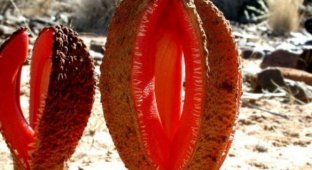12 products that grow completely differently than you imagined (24 photos)
Some of the familiar products have an interesting history and features that we have no idea about. For example, what did the Aztecs eat as diligently as modern healthy eaters? Why do we pay for wasabi and eat horseradish? Which fruits have no smell?
1. Dates


Did you know that dates have absolutely no smell? Therefore, it is recommended to store them in tightly sealed containers, since fruits, especially dry ones, quickly absorb foreign aromas. Dates grow on palm trees, whose height varies from 15 to 25 meters, and the yield of one tree is approximately 100 kg.
2. Capers


A popular seasoning today that gives dishes an spicy taste is the unopened buds of the prickly caper bush. Capers cannot be eaten raw, so they are pickled or pickled before use. By the way, Olivier salad, the original recipe for which was written in a cookbook from 1897, is prepared from capers, and not from pickled or pickled cucumbers.
3. Figs


The fig, also known as the fig or fig tree, “works closely” with fig wasps, which pollinate it. Males do not even have wings - they are born and die without leaving the fig. That is, every fruit contains the remains of wasps. For the highly impressionable, we add that thanks to a special enzyme, insect tissue is broken down into protein, which does not in any way affect the taste of the fruit.
4. Papaya


This exotic fruit is also called breadfruit because when baked, papaya produces a fresh bread-like aroma. In ancient times, green fruits were used as a contraceptive, because the unripe pulp contains substances that reduce reproductive function in both men and women.
5. Cranberry


Cranberries are grown on special plantations (checks) in swampy areas. The berries have small air chambers, and when ripe they float to the surface. When harvesting, harvesters are used on the plantations to beat the water, causing the ripe berries to come off, after which they are collected with a special net.
6. Brazil nut


Brazil nut kernels are in a round box, the weight of which reaches 2 kg. Each of the grains, of which there can be from 8 to 24 in a box, is enclosed in a hard shell. The photo shows a freshly cut Brazil nut that needs to be dried before eating.
7. Pitahaya (dragon fruit)


If you're wondering what a cactus tastes like, try dragon fruit because yes, it's a cactus. At the moment of flowering, the plant is covered with beautiful fragrant buds that bloom at night. To fully enjoy pitahaya, it should be eaten slightly chilled and not combined with foods that have a strong taste.
8. Wasabi


Real wasabi, grown in cold running water, has strong antimicrobial effects, which explains its popular combination with raw fish. The cost of the root reaches € 200 per 1 kg, and it can only be found in Japan. Therefore, outside this country, in most cases, under the guise of wasabi, they serve an imitation - a paste made from horseradish, spices and dyes.
9. Turmeric


Dried turmeric root, when added to food, helps prevent Alzheimer's disease. It is believed that this is why in India, where this spice is traditional, this disease is diagnosed in only 5% of people over 60 years of age, while in other countries this figure reaches 20%.
10. Cloves


A popular spice (especially in winter) is the dried, unopened buds of the clove tree. Cloves have a pungent taste and strong aroma, with the pungency concentrated in the petiole, and the smell is most strongly felt in the cap of the bud.
11. Mustard


Mustard is an excellent antiseptic, and not only its seeds have this effect. Recently, winemakers have been massively using this plant for green manure (enriching the soil) of vineyards. Mustard root secretions contain sulfur, which mole crickets, May beetle larvae, wireworms (click beetle larvae), slugs and other soil-dwelling pests really dislike.
12. Chia


Chia seeds, which are loved by many healthy eating followers, are Spanish sage seeds. Chia is valued for its balanced composition of healthy fatty acids, antioxidants, protein and fiber. In Mexico and other Latin American countries, they have been an integral part of traditional cuisine since the times of the Aztecs.
Undoubtedly, the above facts are a drop in the ocean of what we do not know about our favorite products. What can you add to this list? Tell us in the comments.























